We’ve teamed up with Motorik synth superhero Frank Xavier, who also doubles as an Ableton Liveschool teacher by day for a series of history lessons on cool, quirky, peculiar and classic synths!
Expect a personal story, a bit of history, a couple of streams, a MEGA review and of course a download of playable instruments you can can use in Ableton Live as recorded by Frank and brother in crime, WAV-whiz Yama Indra (Gloves).
In this second installation of the series following the badass run down of the super fun Roland SH-101, they take on another of the all-time-greats – the Korg MS-20 (and it’s little brother the MS-10)…
The KORG MS-20
The key to looking good on stage is the Korg MS20, it’s no trade secret – this cat has been out of the bag for years. If the indie kids are going to have a synth on stage it better look pretty cool – and it does – sitting upright like a miniature grand piano, while being casually tweaked with wine in the other hand. With the MS20 there’s no need to distance yourself from the crowd by hunching over a flat keyboard while fumbling with small knobs and going through presets in the dark.
So in this episode of Retro Synths with Francis Xavier (Motorik) and Yama Indra (Gloves), we will be killing two birds with one stone – we have the Korg MS10 with it’s single oscillator and simple layout and it’s bigger brother the Korg MS20, with a similar architecture and a few minor extras (well not too minor). Again we are going to provide some Ableton-ready free synth sample packs we created for all your production needs.
Both these synths are simple 32 key monophonic hardwired synthesizers. They’re great for beginners but with a catch – they’re both semi-modular which allows for much more complex sound design and synthesis than the average synthesizer – we’ll get to that.
A Little History..
These two synths were spawned in the year 1978 in Tokyo, Japan by a company named Korg, who had been tinkering with electronics since the early 60’s. The US were dominating the world market with Moog and ARP synths at the time, so Korg decided to develop an affordable, efficient and portable Japanese take on the Minimoog, but with the flexibility of the ARP 2600. The MS20 weighed half as much as the Minimoog, had less keys, was almost half the cost and sold over 20,000 units. I must say that it’s black metal finish and plastic sides were no match for the polished wooden exterior of the Minimoog, but the MS20’s lighter weight, stable tuning, durability and readily available electronic components would reign supreme on the road, even over 30 years later.
The MS-20 has been used on countless amazing records. Here’s one to whet you appetite – ever wondered what that squelching bass on Mr.Oizo’s “Flat Beat” was created with? The Korg MS-20. Take a listen…
The Hardwired Controls
First up, I’ll run through the hardwired controls of both synthesizers. Here’s a photo of the hardwired section of the MS20 and the photo below is the MS10. You may want to keep referring back to these shots as I talk through the controls.
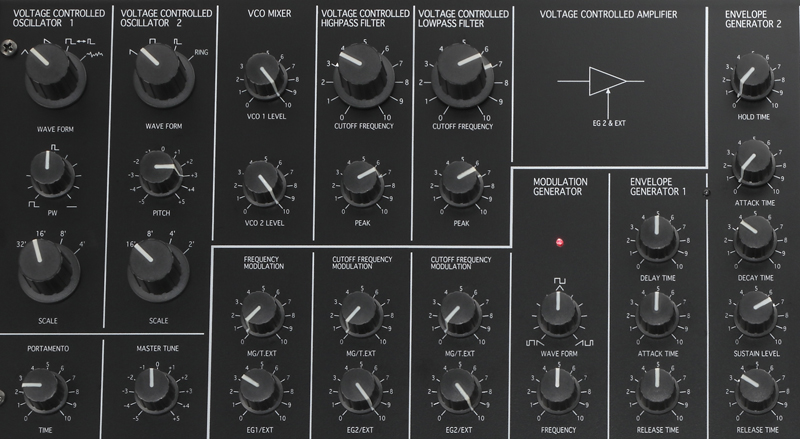
The Korg MS20’s Control Panel
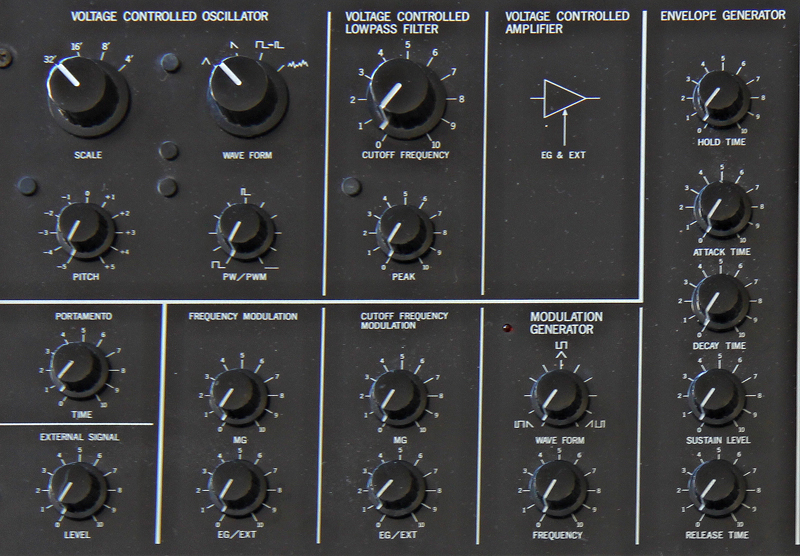
The Korg MS10’s Control Panel
The Voltage Controlled Oscillators (VCOs)
The MS10 comes with a single VCO (Voltage Controlled Oscillator) which is selectable between triangle, sawtooth, pulse waveforms, plus white noise. Below the waveform selection switch there’s a knob for controlling the pulse waveform’s width. On the top right of the VCO section is a 4-step range control (it changes the pitch in octaves) and then below then, a pitch control (for more fine adjustment of the pitch).
The MS10’s big brother the MS20 has all the same features as the MS10, as well as a second VCO with the choice between sawtooth, square, rectangle or ring mod and a 4-step range control (16’, 8’, 4’, 2’). It also then has 2 dials that respectively let you control the levels of the VCO 1 and VCO 2 – so you can get the right mix between the two. Lastly, the MS20 also has a control for the overall tuning of these oscillators.
The Voltage Controlled Filters (VCFs)
Heading to the MS10’s next stage, it’s got a VCF (Voltage Controlled Filter). This is a 12 dB/oct low-pass filter, with resonance (Korg labelled this as “Peak” on their synths at the time).
On an electronic component level, it was originally a factory made KORG35 filter chip – but was exchanged later with an off-the shelf LM13600 OTA (being cheaper and easier to replace). The original KORG35 filter is much harsher, with a warm harmonic distortion, whereas the LM13600 OTA chip is a cleaner and less noisy filter. Personally, I prefer the KORG35 filter as do many others – in fact the love for this filter inspired others to clone it, like the Australian made Frostwave pedal here.
Both the MS10 and the MS20 have an external input to process other external signals through their filters – which I’ve seen a lot bands using live, feeding guitars through the MS20’s filter.
The MS20 adds further VCF options of an additional silky 6dB/oct high-pass filter; which also has peak control (resonance). If you use this in combination with the 12 dB/oct low-pass filter – then you have an instant band-pass filter.
The Voltage Controlled Amplifier (VCA) & Envelope Generators (EG)
To amplify this signal and get it out there – we head to the VCA (Voltage Controlled Amplifier). The VCA is pretty much a single 2SC945 transistor that you can buy for less than 5 cents.
The MS10s VCA can be modulated by a 4 stage Attack, Decay, Sustain and Release (ADSR) envelope with an added extra – a hold function (making it HADSR), which controls how long the the sound will play for when a key is pressed – regardless of the ADSR settings. This envelope is not particularly fast – being linear in nature, rather than exponential. As well as the VCA, the envelope can also be assigned to modulate the filter (VCF) and the frequency (pitch) of the oscillator (VCO).
The MS20 has two of these envelope generators. The first is set up to modulate the VCO frequency, while the second envelope generator can be assigned to control the VCA, high-pass filter or low-pass filter.
The LFOs
The Korg MS10 has an LFO for modulation, labeled as the “Modulation Generator”. The LFO can control the frequency of the oscillator or the low-pass filter’s cutoff frequency using square, pulse or ramp (AKA reverse sawtooth) waveforms.
The MS20 has the same LFO (again labelled as “Modulation Generator”), however on the MS20 the LFO can also modulate the cutoff frequency of the hi-pass filter.
Getting Modular
Okay, we got through the hardwired part of these synths – simple right? Now lets approach the semi-modular features with an open mind!
Here’s a couple of photos to refer to – the first is the modular patching panel of the MS20, the second one is the MS10.
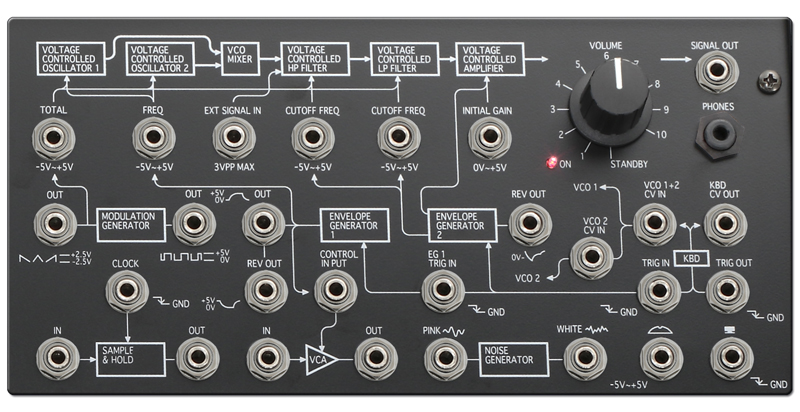
The Korg MS20 modular patch panel
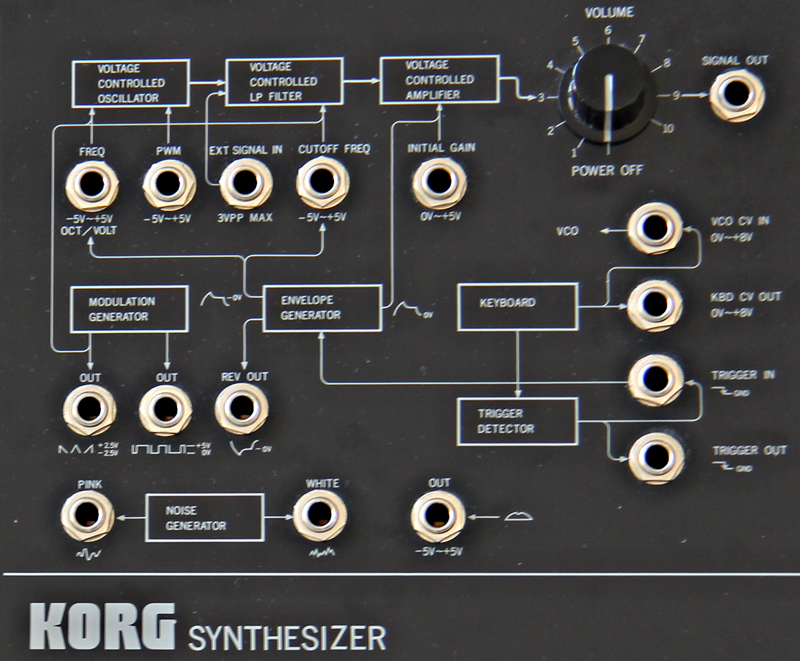
The Korg MS10 modular patch panel
A basic analog synthesizer is a bunch of modules – perhaps a VCO, VCF, VCA, and an LFO module – hardwired to a fixed signal path. A modular synthesizer on the other hand isn’t fully hardwired. A modular synth can consist of as many modules that your wallet can handle, which can then be connected any which way you want (within reason).
Both the MS10 and the MS20 are semi-modular. This means they can be used as standalone hardwired synths, but also have extra synthesis capabilities and options accessible through their panel of modular inputs and outputs.
Patching out of the MS10, we see outputs for the LFO pulse and ramp waveforms, a negative envelope control signal and a noise generator (generating pink or white noise). There’s also a mod wheel out, providing a 5 volt source which can be used for pitch bends.
Patching into the MS10 you can control the VCO frequency and Pulse Width Modulation. There’s also the external input into the VCF I mentioned earlier. Other patching options here are the CV and GATE in and outs and the trigger in and outs – for interfacing with other synths (no MIDI yet, it’s 1978). Sadly while most synths use the standard volts per octave for CV, the Korg MS10 and MS20 use hertz per volt, in other words you would need to converter to let these these two synths communicate with the rest of the synth world. Some of the Kenton products include these convertors so all is not lost. The trigger out is also a foreign signal called s-trig (short circuit trigger), used by Moog, Korg and Yamaha and perhaps others. This also needs to be converted to a v-trig (voltage trigger) to communicate with Roland and Sequential Circuit synths and probably numerous other synths as well.
The MS20 has all the patching options of the MS10 plus so much more. There’s a trigger input for envelope 1, an input, output and clock for sample & hold, VCA in and out, high-pass filter input, independent CV ins for both VCO 1 and VCO 2, an external signal processor section for bandpass filter outs, an envelope follower out and a trigger out.
Have I missed something? Yes, a frequency (pitch) to voltage convertor – can you believe it? These are pretty rare, imagine being able to plug in a guitar and have the notes converted into control voltages (so basically, the MS20 can mirror what you’re playing on guitar simultaneously!). I definitely need to try this.
In the Studio…
The Korg MS10, I must admit, does not get that much love in my studio. It’s great for a harsh buzzy, sawtooth sound and I can get some pretty basic electro bass out of it. Sometimes I’ve put an external signal through it’s filter just for kicks. The noise generator can be pretty good for sweeps, but really it’s the MS20 or nothing in my opinion.
When I’m in need of harsh sounding riffs the MS20 is definitely the go to synth, using that ring mod on VCO 2. It’s also good for basses – but then you can get a good bass out of most things. For me, the unique power of the MS20 lies in the high-pass filter and low-pass filters being modulated. When using these filters together to create a bandpass filter and using the peak control, you can make some pretty interesting drum sounds. Hands down, the MS20 is great for sound effects and external processing once you get your head around the modular section.
Putting this all down on paper has got me excited about the MS20 again; I may even get out my little patch cords and start experimenting.
Getting your hands on one
If you are thinking of grabbing one of these gems you are looking at around $800 for an MS10 or $1,200 for an MS20 – but there’s a few options around now for getting the sounds of these units…
Korg re-released the MS20 last year for around $800 as the Korg MS-20 Mini – with USB, MIDI, 37 mini keys and the exact electronic specifications of the original MS20 (including the KORG35 filter. It’s physically smaller than the original and the patch points are now mini jacks, but the sound is in there.
Still not good enough? This year they also re-released the Korg MS20 Kit. This is an Ikea style flat pack that even my mum could put together if I gave her a screwdriver and a hex key. This MS20 kit is exactly the same as the original MS20 both electronically and physically, but with a nerdy twist – you can select with a jumper what filter version you want (either the KORG35 filter chip or the LM13600 OTA – I know which one I would go with!). It also has USB and MIDI as you’d expect in a modern synth. This new kit will set you back around $1,600.
There’s also a couple of pretty faithful digital recreations you might want to get your hands on – the Korg Legacy Collection (which sounds great) and then there’s an iOS app – the Korg iMS-20, which is only $30 bucks.
Try it out – Korg MS-20 Free Synth Sample Pack
Before you go spending money on one of these, Frank & Yama at Liveschool have put together an MS20 synth pack for Ableton Live that you can have for free. In there you’ll find 8 presets they’ve designed, plus 4 raw cycling waveforms to use to create your own presets, all multisampled from Frank’s very own MS20. Enjoy!
Want to learn more about sound design and synthesis? Check out Liveschool’s Sound Design course and grab the last free synth pack of the killer Roland SH-101.
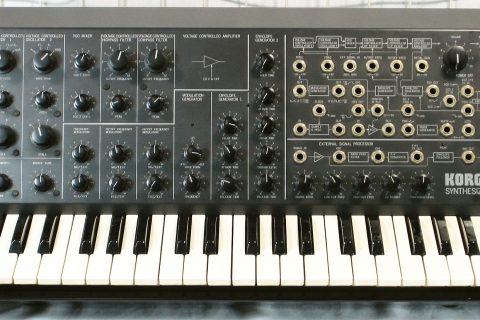




Comments